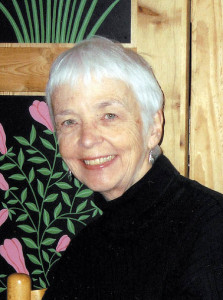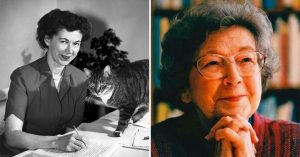by Katherine Handcock, A Mighty Girl Senior Research Intern
 Today we continue our Mighty Girl Creators Series with our latest installment: an interview with esteemed author and illustrator Jeanette Winter. Ms. Winter is the creator of numerous highly regarded picture books, many of which feature the true stories of amazing women.
Today we continue our Mighty Girl Creators Series with our latest installment: an interview with esteemed author and illustrator Jeanette Winter. Ms. Winter is the creator of numerous highly regarded picture books, many of which feature the true stories of amazing women.
Ms. Winter loves writing about artists, since her own desire to be one growing up has resulted in a fascination with the artistic process, though she also writes about any story that captures her interest. Her latest book, due for release in the summer of 2013, is Henri’s Scissors, the story of Henri Matisse’s work in his later life.
On A Mighty Girl’s website, we feature several of Winter’s books, including the picture book biographies My Name Is Georgia, about artist Georgia O’Keeffe; The Watcher: Jane Goodall’s Life with the Chimps; and Wangari’s Trees of Peace: A True Story from Africa about Nobel Peace Prize winner Wangari Maathai. Her book The Librarian of Basra: A True Story From Iraq tells the amazing story of Alia Muhammad Baker’s rescue of the books during the invasion of Iraq. And Nasreen’s Secret School: A True Story from Afghanistan is a testament to the power that reading and books can have to heal even the deepest wounds.
Winter lives in New York City with her husband, painter Roger Winter. You can read more about Winter’s life and writing at her Macmillan author page or her Simon and Schuster author page.
A Mighty Girl’s Interview with Jeanette Winter
1. Your books tell a wide variety of stories, everything from events hundreds of years in the past to the present day, and even folk tales. What is it about a story that prompts your desire to write about it?
I have to immediately like the story, somehow identify with it, and also be excited about the picture possibilities. Sometimes I see the pictures first, other times the story, but I have to see both working together.
2. Many of your stories feature inspiring women — people like Jane Goodall, Wangari Maathai, Alia Muhammad Baker, and Georgia O’Keeffe. Why do you feel it is important to feature strong women in your stories?
![okeefe01[1]](https://www.amightygirl.com/wp/wp-content/uploads/2013/04/okeefe011-253x300.jpg) I’m committed to the picture book form, and hope that young children, especially girls, would have early exposure to strong role models, and to see ALL the possibilities that life has to offer. When I was a child in the 40’s, such a book was rare. I don’t ever remember reading one. I always wanted to be an artist, but I had no role models. So I stumbled along in the dark, hoping my dream would somehow become true. My Name Is Georgia is a book I wish I could have read all those years ago. In the world I knew then, all the grown-up artists were men.
I’m committed to the picture book form, and hope that young children, especially girls, would have early exposure to strong role models, and to see ALL the possibilities that life has to offer. When I was a child in the 40’s, such a book was rare. I don’t ever remember reading one. I always wanted to be an artist, but I had no role models. So I stumbled along in the dark, hoping my dream would somehow become true. My Name Is Georgia is a book I wish I could have read all those years ago. In the world I knew then, all the grown-up artists were men.
3. Some of these stories feature situations that are difficult for younger children in developed nations to grasp — living in a war-threatened area, for example, or in a situation where girls are considered obviously inferior to boys. How do you make these ideas accessible to younger readers?
First, I strive for simplicity in the words and pictures. Second, the story must be strong. In The Librarian of Basra Alia’s brave rescue of the books in her library is the story I focus on. That it happened in a war-torn country makes it all the more remarkable. I handle the aspect of war less directly — coming in ‘from the side’. Depending on a child’s age, they will take with them what they can understand. A very young child will focus on Alia, the brave librarian. Older children will incorporate the war — as it was shown non-stop on the news. Also I work hard to tell such stories in an even-handed manner.
4. Your story The Librarian of Basra was inspired by reading a single newspaper article about Alia Muhammad Baker’s efforts to save the books at the Central Library. You’ve said in a previous interview that hearing about her gave you a sense of “the optimism of the human spirit.” How do you try to communicate that optimism through your writing?
![The_Librarian_of_Basra[1]](https://www.amightygirl.com/wp/wp-content/uploads/2013/04/The_Librarian_of_Basra1-224x300.jpg) Many of the people I write about accomplish amazing feats without any encouragement, and under the most difficult, even dangerous, conditions. Their strong belief in — and desire to — follow their hearts, is inspiring to me. Through the story and pictures, I try to make something seemingly impossible seem possible.
Many of the people I write about accomplish amazing feats without any encouragement, and under the most difficult, even dangerous, conditions. Their strong belief in — and desire to — follow their hearts, is inspiring to me. Through the story and pictures, I try to make something seemingly impossible seem possible.
And when I can, I include direct quotes from the main character of the book. I know I would have paid close attention to something the main character actually said. When I read that Wangari Maathai told her children (“Right is right, even if you’re alone”), I knew I had to include that in the book.
5. Many parents and educators argue that children aren’t interested in history, but the success of many of your historically-based books obviously shows otherwise. What do you think is necessary to foster a child’s interest in a historical story?
I think the way to present history to children is through good, accurate storytelling. Often an historical story will need to be simplified. In my non-fiction books, I always ask myself, “OK, what is important here?” I pare the story down to the basics —what the person did, and why it’s important. No extra side stories, facts, and figures. That can come later.
6. Unlike many children’s authors, you’re also an illustrator (for both your own and other authors’ work.) How do you approach illustrating a story to make it appealing to readers?
![wangaris-trees[1]](https://www.amightygirl.com/wp/wp-content/uploads/2013/04/wangaris-trees1-226x300.jpg) Basically, I try to make pictures I would have liked as a child, and I had very definite likes and dislikes. Again, I also strive to use the illustrations to carry the story forward.
Basically, I try to make pictures I would have liked as a child, and I had very definite likes and dislikes. Again, I also strive to use the illustrations to carry the story forward.
7. You’ve said that “comic books and library books” were equal favorites of yours as a child. Were there particular Mighty Girl characters or books that particularly spoke to you as a child?
I loved Wonder Woman comic books — all her heroic deeds, and her wonderful outfit!
8. In your opinion, what books are must-reads for the Mighty Girls of today?
I would recommend the poems of Emily Dickinson. Also, Persepolis by Marjane Satrapi.
9. Your sons are both poets, so you obviously know a thing or two about fostering creativity in children. What do you recommend to parents who want to make sure that their girls don’t lose their creative voices as they get older?
My husband is a painter, so our sons grew up in an artistic community. In their middle school and high school years, we held poetry readings in my husband’s studio. Neither I nor my husband grew up in families that particularly encouraged artistic pursuits. But, importantly, no one discouraged me. I was on my own, drawing my pictures, happy.
![8988888[1]](https://www.amightygirl.com/wp/wp-content/uploads/2013/04/89888881-300x300.jpg) The main advice I would give to parents would be don’t stand in your child’s way: encourage their efforts, helping them to realize that there is no one “right way” to make a picture, or to write a poem or story. The important thing is in the ‘DOING’.
The main advice I would give to parents would be don’t stand in your child’s way: encourage their efforts, helping them to realize that there is no one “right way” to make a picture, or to write a poem or story. The important thing is in the ‘DOING’.
In my early grades in school, art period meant taking crayons out of our desks, the teacher passing around paper, and we each would begin drawing a picture, usually of whatever we wished. Heaven!
Let your child explore! Have materials available. The child will do the rest.
10. Do you have any new books in the works? Are there more women whose stories you would like to tell?
In August 2013, Henri’s Scissors will be published. The book is about Henri Matisse when he was an old man, sick, and confined to bed or wheelchair. Despite these challenges, he did the best work of his life — the paper cut-outs. Again, the “optimism of the human spirit”.
Yes, I do have 2 women in mind for future books, but at this point the ideas are still just floating around in my mind.
Additional Resources
- To view a list of all of Jeanette Winter’s books on A Mighty Girl, visit our Jeanette Winter collection.
- To read our prior interviews in the A Mighty Girl Creator series, visit our posts featuring our interviews with Ingrid Law and Doreen Rappaport.
- For more true stories for children and teens about remarkable girls and women, visit our collection of nearly 400 biographies.














